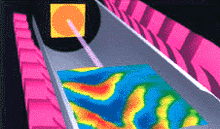![]()



WHISTLER WAVES are one of the many kinds of waves that exist
in plasmas. A whistler wave is shown propagating through density striations
in a laboratory plasma. Panel (a) shows the experimental apparatus. Panel
(b) shows the plasma discharge, and panel (c) shows the nonlinear wave pattern.
This experiment allows controlled observation of nonlinear whistler-wave
activity, which is an important process in the Earth's upper atmosphere.
[Courtesy, Walter Gekelman, University of California, Los Angeles]
when one or the other species lags slightly behind in the thermomechanical dance.
Most remarkable of all is the ability of a plasma to damp away its waves when collisions between particles are negligibly rare. This collisionless damping occurs when some of the plasma particles are moving with close to the same velocity as the wave phases themselves, so that the particles ride the disturbance like a surfer on a water wave. The particles gain energy while the wave loses energy and damps away. In this way, a wave may be said to "heat" the surrounding plasma. Some theories invoke this mechanism to help explain the mysteriously high temperature of the sun's corona. Certainly one of the most interesting and engaging plasmas in the universe, this prominent solar feature-seen as the bright, wispy halo during an eclipse-has a measured temperature of over a million degrees centigrade, while its only apparent source of heat, the solar surface below, sits at just 6,000 degrees. Perhaps, some theorists propose, the sloshing,
turbulent motions at the sun's surface generate waves that propagate upward and
dump their energy into the corona.
![]()
In terrestrial laboratories, experimentalist call on a similar effect to accelerate bursts of electrons to high energies. The idea is to excite large-amplitude Langmuir waves by firing brief, super-intense laser pulses into a plasma. The laser pulses have a pressure that shoves plasma electrons out of the way. This lets a pulse act like a sort of speed boat, and in its wake are huge waves whose electric fields can be used to accelerate electrons to high energies. These fields are so strong that they would tear apart material structures; so it is not surprising that particle accelerators based on this effect could one day be both more powerful and tens or hundreds of times smaller than those that use conventional technologies, which require such structures - copper cavities and the like. Though they have obtained a number of promising results, plasma researchers are still at the early stages of harnessing this intriguing effect.
Up to this point, we haven't thrown magnetic fields into the cosmic brew that defines plasma physics. But it is only when magnetic fields are considered that plasma's astonishing complexity and variety become fully apparent, and you can understand the intellectual fascination, the utopian dreams and the Kafkaesque nightmares that the substance has planted in the minds of many a researcher.
A magnetic field's profound influence on plasma properties owes to its effect on the orbits of the individual charged particles. Like rings sliding along wires, electrons and ions for the most part move easily along magnetic field lines but spiral tightly around them. The spiraling effect greatly inhibits the ability of charged particles to travel across field lines.

PARTICLE-WAVE SURFING and mixing occur when charged particles
interact with waves. A plasma can often be viewed as a layered fluid with
the layers having different fluid densities. Waves in the plasma cause these
layers to first "surf" and then mix with particles in other layers.
The start of the mixing is illustrated below, where different layers are
color-coded to visualize the evolution of mixing that often leads to chaos.
This physical picture is applicable to many different plasma processes occurring
in the laboratory, in space, and in commercial applications. [Courtesy,
Michael Mauel, Columbia University]
![]()